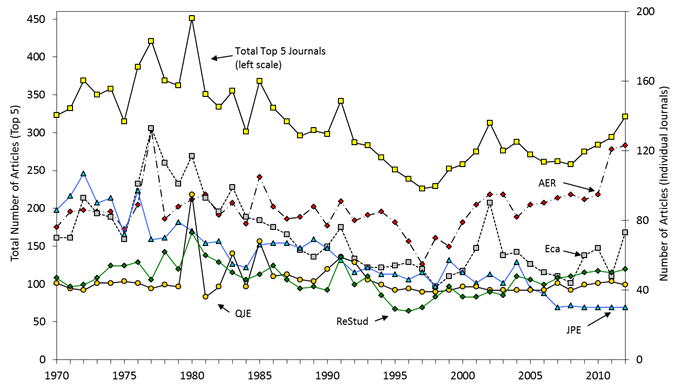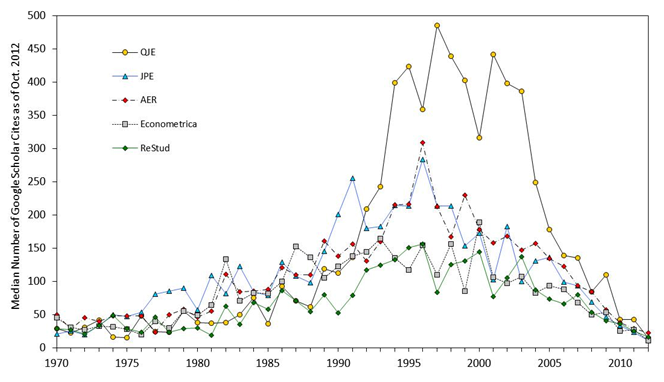Publications in the top journals have a powerful influence on the direction of research in economics, on the career paths of young researchers (Conley et al. 2011), and on the pay of academic economists. To what extent has the publication process in these journals changed over the past few decades? Remarkably little comprehensive evidence exists on the topic.
In Card and DellaVigna (2013), we present a descriptive overview of trends among the papers published in the 'top five' economics journals: The American Economic Review (AER), Econometrica (EMA), the Journal of Political Economy (JPE), The Quarterly Journal of Economics (QJE), and The Review of Economic Studies (RES). We exclude papers published in the "Annual Papers and Proceedings" issue of AER, as well as notes, comments, and announcements. We combine data from EconLit on all articles published in these outlets since 1970 with matched citation data from Google Scholar and annual submission counts from the journals. Our analysis builds on the study by Ellison (2002) but extends his work in several directions, including the consideration of paper-specific citations.
We identify nine key trends. First, as Figure 1 shows, the number of yearly submissions to the five top journals nearly doubled from 1990 to 2012. The increases are especially large for QJE and RES, but are clearly present for all the journals except JPE, which received about the same number of submissions in 2011 as in 1987-1989. It is also interesting to note that most of the secular increase in submissions documented in the figure has occurred since the year 2000.
Figure 1. Number of submissions per year
Second, as Figure 2 shows, the total number of articles published in the top journals declined from about 400 per year in the late 1970s to around 300 per year in 2010-12. The combination of rising submissions and falling publications led to a sharp fall in the aggregate acceptance rate, from around 15% in 1980 to 6% today. Currently, QJE is the most selective of the top-five journals, with an acceptance rate of around 3%, followed by JPE and RES, with acceptance rates of around 5%. The least selective of the top-five are AER and Econometrica, with acceptance rates of around 8%.
Figure 2. Number of articles published per year
Notes: Publications exclude notes, comments, announcements, and Papers and Proceedings. Totals for 2012 estimated.
Over time, and especially during the last 15 years, it has become increasingly difficult to publish in the top five journals. Other things equal, this suggests that hiring and promotion benchmarks based on top-five publications (e.g., “at least one top-five publication for tenure”) are significantly harder to reach.
Which journals are most responsible for the decline in the number of articles published? The largest decreases are for Econometrica, which cut the average number of articles per year from around 100 in the 1970s to 60 today, and the Journal of Political Economy, which published 85 articles per year in the 1970s but now publishes only 30 articles per year. QJE and RES also experienced declines but of smaller magnitudes. Only The American Economic Review has increased the number of articles published today relative to the late 1970s, from about 100 per year to around 125 per year.
As a consequence, our third fact, The American Economic Review now accounts for 40% of top journal publications in the field, up from 25% in 1970. In contrast, JPE, which also published about one quarter of all top-five articles in the late 1970s, now publishes less than 10% of these articles. Stated differently, in the late 1970s AER and JPE had about equal say in the gatekeeping process that determined publications in the top-five journals. Now AER has four times greater weight than JPE.
Fourth, we document the trends to the length of published articles. To do so, we normalise the length of articles to adjust for the different page density in different journals. As Figure 3 shows, we find that published papers in the top five journals are nearly three times longer today than they were in the 1970s. Indeed, a paper in the 90th percentile of length among published papers in 1970 is shorter than a paper in the tenth percentile of length among papers published in 2012. Furthermore, the five journals moved in a remarkably parallel way over time.
Figure 3. Trends in length and number of authors of published papers
Notes: Page lengths are adjusted for differences in page density across journals. Standardised length includes 2550 characters per page.
This substantial increase in page length of articles has led several journals to consider or implement page limits in newly submitted articles. In a separate paper (Card and DellaVigna 2012), we study the impact of page limit policies adopted by The American Economic Review in 2008 and the Journal of the European Economic Association (JEEA) in 2009 in response to this substantial increase in the length of articles.
We focus the analysis on the decision by potential authors to either shorten a longer manuscript in response to the page limit, or submit to another journal, and show that under a simple set of assumptions one can infer a threshold for shortening papers from the observed change in the number of submitted papers of different length before and after the page limit imposition.
Using a detailed data set measuring the length of all submissions in a time range before and after the page limit imposition at both journals, we evaluate the decision of authors. For AER we find no indication of a loss of longer papers. Instead, authors responded by shortening the text and reformatting their papers. For JEEA, in contrast, we estimate that the page-length policy led to near-complete loss of longer manuscripts.
These findings provide a revealed-preference measure of competition between journals, and indicate that a top-five journal has substantial monopoly power over submissions, unlike a highly respected journal one notch below.
At both journals we find that longer papers were more likely to receive a revise and resubmit verdict prior to page limits, suggesting that the loss of longer papers may have had a detrimental effect on quality at JEEA. Despite a modest impact of AER's policy on the average length of submissions (-5%), the policy had little or no effect on the length of final accepted manuscripts. The results in Card and DellaVigna (2012) highlight the importance of evaluating editorial policies with state-of-the-art empirical methodologies.
Going back to the nine facts in Card and DellaVigna (2013), the fifth fact is that the number of authors per paper has increased monotonically over time. In the early 1970s, three quarters of articles were single-authored, and the average number of authors in a paper was 1.3. By the early 1990s, the fraction of single-authored papers had fallen to 50%, and the mean number of authors reached 1.6. Most recently (2011-2012), more than three quarters of papers have at least two authors and the mean number of authors is 2.2. This shift worked to partly offset the decrease in the number of articles published per year. Indeed, weighting each paper by the number of co-authors, the number of authors with a top-five journal article in a given year is somewhat higher today than in the 1970s or 1980s.
Sixth, papers published in the top five economics journals are highly cited. Among those published in the late 1990s, for example, the median article has about 200 Google Scholar citations. As Figure 4 shows, citations for more recently published articles are lower, reflecting the fact that it takes time to accumulate citations. Interestingly, papers published in the 1970s and 1980s also have total citation counts below those of papers published in the 1990s, reflecting the nature of the sources used by Google Scholar, citation practices of current authors, and other potential factors.
Figure 4. Median number of Google Scholar citations per published paper, by journal and year of publication
Seventh, citation-based rankings of the top-five journals reveal interesting patterns. Median citations for articles in The American Economic Review and the Journal of Political Economy tend to be quite similar from year to year – for example, around 100 in the late 1980s, between 250 and 300 in the mid-1990s, and around 130 in 2005. In the earlier years of our sample, articles in Econometrica have about the same median citations as those in AER or JPE. Starting in the 1990s, however, there is a discernible fall in the relative impact of Econometrica articles. Articles in The Review of Economic Studies tend to be the least cited among the top five journals, although its relative position appears to be improving in the last few years.
Perhaps the most obvious feature is the dramatic increase in relative citations for articles in The Quarterly Journal of Economics. Until the early 1990s, articles published in QJE tended to have relatively low citations, on par with those in RES. Between 1990 and 1992, though, median citations for articles in QJE rise to the top of the group. Indeed, in the years from 1994 to 2004, median citations for articles in QJE are about two times larger than median citations for articles in AER and JPE, and about three times the median for articles in Econometrica and RES. Median citations for more recently published articles are lower, but QJE remains the journal with the highest median citations per paper in all years from 1991 to 2011.
Eighth, using a regression-based analysis, we show that citations are strongly increasing in both the length of a paper and the number of coauthors, suggesting that trends in both dimensions may be driven in part by quality competition. The effects hold both when predicting the number of citations (in logs) and when predicting the probability of an article in the top 5% of citations in a given year.
Ninth, despite the relative stability of the distribution of published articles across fields, there are interesting differences in the relative citation rates of newer and older papers in different fields. In particular, papers in Development and International Economics published since 1990 are more highly cited than older (pre-1990) papers in these fields, whereas recent papers in Econometrics and Theory are less cited than older papers in these fields.
Overall, these findings have potentially significant implications for academic economists, particularly with regard to the career paths of younger scholars. Most importantly, the competition for space in the top journals has grown fiercer over time. The overall acceptance rate for submissions at the top five journals is about one-third as high today as in the early 1970s. This trend is independent of the trend documented by Ellison (2002) toward longer delays in the adjudication and revision process, and in fact has largely emerged in the decade since Ellison’s original investigation. Both lower acceptance rates and longer delays, however, make it increasingly difficult for any one author to achieve a given set of publication benchmarks. Authors have clearly responded by forming bigger teams, and to the extent that co-authored papers are treated as equivalent to single-authored ones, they have been able to partially mitigate the adverse effects of lower acceptance rates and longer delays.
References
Card, David and Stefano DellaVigna. “Revealed Preferences For Journals: Evidence from Page Limits” NBER Working paper 18663, December 2012.
Card, David and Stefano DellaVigna. “Nine Facts about Top Journals in Economics”, Journal of Economic Literature, March 2013.
Conley, John P, Ali Sina Önder, Mario Crucini and Robert Driskill, “Publication lags and young economists’ research output”, VoxEU.org, 24 October 2011
Ellison, Glenn (2002). “The Slowdown of the Economics Publishing Process.” Journal of Political Economy 110 (October 2002): 947-993.






